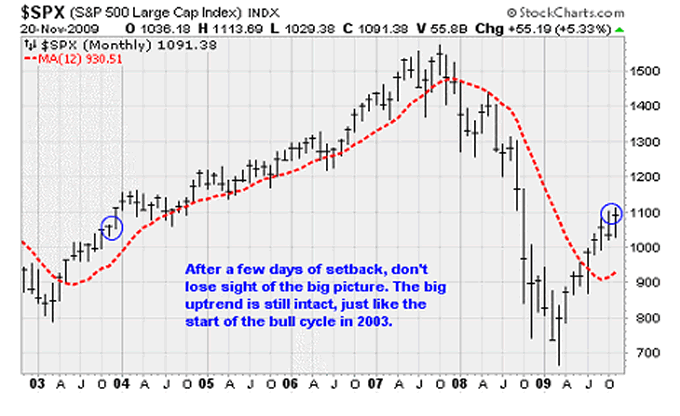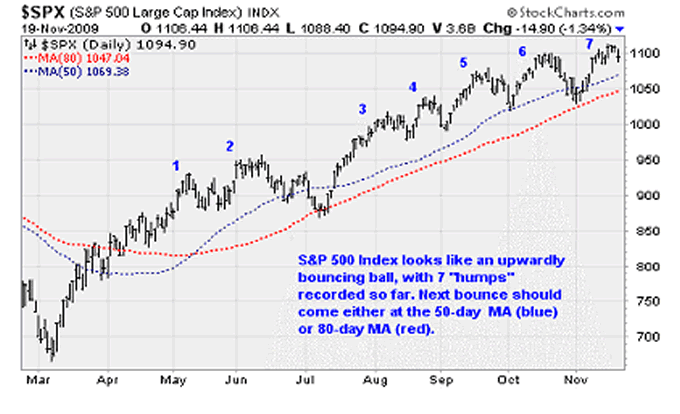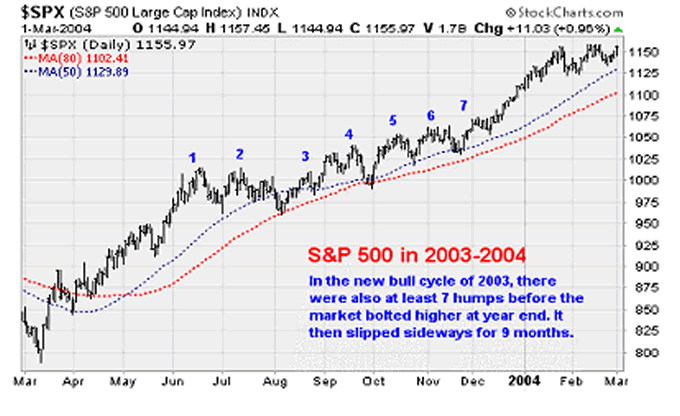Don’t Miss Out on the Looming Gold Bubble
Stock-Markets / Financial Markets 2009 Nov 23, 2009 - 08:45 AM GMTBy: Money_Morning
 Jon D. Markman writes: Gold was all the rage again last week. But why is it rising, and does anyone really know what it’s worth?
Jon D. Markman writes: Gold was all the rage again last week. But why is it rising, and does anyone really know what it’s worth?
According to the way I calculate momentum, gold has just barely entered the gravity-free zone – where it has the potential to start advancing a lot, with much more fluidity.
And that translates into much higher prices.
Although I normally abhor such popular and trendy positions, the trend-following rules in my asset-allocation models are screaming for a higher weighting than the current 5% in the portfolios that I track in my Strategic Advantage newsletter.
The London Telegraph had an interesting analysis on Thursday, based on an interview with Dylan Grice of Societe Generale SA (OTC ADR: SCGLY). The French analyst said the recent jump related to the purchase of a massive amount of gold by the Indian central bank was very similar to the French central bank’s effort to convert dollars to gold in 1965, the slippery slope that led to the collapse of the Bretton Woods currency agreement and the close of gold sales under U.S. President Richard M. Nixon.
Grice recalls that, in the wake of the French move back then, the price rose to a level that matched the U.S. dollar monetary base and peaked at 140% of that amount. If that were to recur, Grice said, in the wake of the big money print exercised by the U.S. Federal Reserve under Chairman Ben S. Bernanke, gold would have to reach a little more than $6,400 an ounce. (The calculation is simple: The monetary base is $1.7 trillion and the United States owns 263 million ounces of gold. Divide, and voila!)
Could this happen? Well don’t let anyone fool you. Gold is almost completely worthless except to the extent that people of an era like to own it, and as such it has varied wildly in price over the years.
Grice notes that is trading at roughly the same real price now as in the mid-1400s, when an ounce bought a light suit of chain mail. It then doubled in the Medieval bubble – yes, they had bubbles back then, too — then crashed 90% over the next 500 years once the Spanish discovered scads of gold in the New World and there were a few minor finds in places like California, Australia, South Africa and Russia.
Grice told the Telegraph: ”Gold isn’t intrinsically safer than any other asset. There is nothing mystical about it, either.” And yet its uselessness is part of its charm, making it almost the perfect currency in a time of inflated paper money.
Considering that virtually all major Western nations and Japan are insolvent now, with far more debt than gross domestic product (GDP), you can see why emerging countries like China and India, which have not yet advanced to the point of bankruptcy, would want to get their hands on it. Every generation will value things that are important to it differently. Back in the heyday of Holland, tulips were more valuable than gold for instance; and in the heyday of the Internet bubble, you could get financing for a startup company based on a multiple of clicks and eyeballs.
On Wednesday night, a friend in the hedge fund business told me about a dinner hosted by Goldman Sachs Group Inc. (NYSE: GS) in London last week where the subject of gold’s value came up. Goldman asked the room full of 15 or so major hedge fund managers to mark down on a piece of paper the price at which they thought gold would trade over the next two years. The consensus answer was an astonishing $4,000 per ounce.
Whether that’s the right number or not, it’s clear that gold has become the most loved instrument in the world of late. I really don’t think it has moved into bubble territory yet as it is mostly just discussed in these terms by wizened gold bugs with stains on their shirts, shady Vancouver Exchange stock promoters and hedge fund muckety mucks. Once my sisters and neighbors start asking where they can bogart some bullion, I will call bubble, and not before.
Credit to Stocks
Let’s end on a positive note. Corporations are enjoying easy access to credit and are increasingly using this cash to repurchase stock. According to UBS AG (NYSE: UBS) Strategist Thomas Doerflinger, the bank’s U.S. clients have started buying equities again after 16 straight weeks of selling, thanks to the efforts of corporate clients and long-only mutual funds. The buying is concentrated in technology and materials. Hedge funds – which tend to be very short-term oriented, so don’t make too much of their actions – continue to sell and sell-short, and are focused on the industrial and financial sectors.
Analysts at Bank of America Corp.’s (NYSE: BAC) Merrill Lynch unit note that the cost of debt is now below earnings yield — which is the inverse of the price/earnings multiple. Historically, when this has happened, executives "become more aggressive and reward shareholders at the expense of bondholders."
That sounds pretty arcane so let me just put it plainly: It’s good news. Think share repurchases, mergers, and acquisitions and yet more support for earnings multiples and stock prices.
If this continues to play out, it would be typical behavior for the cruel market gods: Remember that we’ve seen a flood of retail investor money flow into bond funds at the expense of equities.

The supply of funds is certainly there: Merrill Lynch reports that new borrowing by high-grade issuers has matched the record annual volume of $960 billion set in 2007. And we still have one more month to go in the year! This sets the stage for a $1 trillion year for 2009. Amazing.
A few companies that have issued new debt have gone as far as to mention share buybacks as a possible use of the money. These include Cisco Systems Inc. (Nasdaq: CSCO), Praxair Inc. (NYSE: PX), Quest Diagnostics Inc. (NYSE: DGX), International Business Machines Corp. (NYSE: IBM) and Zimmer Holdings Inc. (NYSE: ZMH). This is quite a cross section of the market. We’ve got a network hardware maker, an industrial gas supplier, a provider of healthcare testing services, and a medical device manufacturer.
Keep in mind that much of the entire 2003-2007 bull cycle was fueled by buybacks and mergers, as the public was still largely in shock over the 2000-2002 bear market. Buybacks are no joke, as they really help push prices higher by reducing the supply of shares.
Cheap credit is thus one hidden reason that stocks can keep moving higher even if the economy seems to be lousy. Buybacks react to a totally different dynamic than equity investors are accustomed to seeing and understanding. Keep an ear out for that word, and smile when you hear it.
Week in Review
Stocks moved lower again on Friday for the third consecutive daily decline. Investors continued to move away from risky assets, bidding up the dollar and short-term U.S. Treasury bills in a search for profit-taking or safety, depending on their time frame.
The intraday chart of the indexes suggests some options expiration funny business was afoot as volatility plummeted into the closing bell — pushing the major indices up off their lows and towards the unchanged line in the last hour of trading.
The Dow Jones Industrial Averagelost 0.1%, the Standard & Poor’s 500 Indexlost 0.3%, the Nasdaq Composite Indexlost 0.5%, and the Russell 2000 lost 0.2%. For the week, the Dow gained 0.5% while the Nasdaq lost 1% — bringing an end to a two-week advance.

The big picture is still very positive, and would not even be derailed by several weeks like the one just past. Multi-week consolidations are extremely common within even the strongest uptrends; we are just spoiled lately by the incredible and even historic strength of the move we have witnessed over the past eight months.


To show you what’s happening a little more clearly, let’s look at the charts a little more closely. Consider that the pattern that’s being traced out so far in the S&P 500 Index is very similar to what we saw in the latter few months of 2003 in the second stage of that new bull cycle.
You can see the comparison in the charts above. At around the same time in late November 2003, the big-cap U.S. index came down for one more touch-and-go of its 50-day average for a few days (#6 in its chart) before scampering higher through December and January. These patterns never repeat exactly, but the match so far is so close it’s worth pondering as a road map.
Monday: Retail sales jump more than expected for October, increasing 1.4% thanks to a 7.4% rebound in auto sales after the post cash-for-clunkers slide of 14.3% in September. Analysts were expecting 0.9%. This was a big improvement from September’s 1.5% drop and bodes well for the upcoming holiday shopping season that kicks off next week.
Tuesday: Industrial production slipped slightly in October, increasing just 0.1% compared to the 0.6% expansion in September and the consensus estimate of 0.4%. A decline in auto production was the main culprit for the decline as sales slowed that month. Highlights include a 1.9% jump in appliance and furniture output, a 3.6% increase in metals output, and a 1.4% increase in paper output.
Wednesday: Housing starts fell unexpectedly in October as the apartment business remains under pressure with high vacancies and low demand for new construction. Starts dropped 10.6% after jumping 1.9% in September. Multifamily building starts plunged 34.6% while single-family starts dropped 6.8%. Some of the decline probably reflected homebuilder concerns surrounding the potential expiration of the first-time homebuyer tax credit. Of course, it was renewed.
Thursday: The index of leading economic indicators gained 0.3% last month thanks mainly to the difference between short- and long-term interest rates — which contributes to the profitability of the banking sector and is a reflection of the bond market’s expectation of the economy’s future health. Wider is better.
Friday: No major economic releases.
The Week Ahead
Monday: Existing home sales will be reported. Analysts expect 5.7 million for the month of October on a seasonally-adjusted annual rate. This would be an increase over September’s 5.6 million.
Tuesday: The government releases its revised estimate of third-quarter GDP. The advance estimate beat expectations by coming in at 3.5%. Analysts expect this to be downwardly revised to 2.8% as a result of deterioration in the trade balance and business inventories.
Wednesday: A heavy calendar ahead of the holiday. We will get durable goods orders, personal income and outlays, weekly jobless claims, consumer sentiment, and new home sales.
Thursday: Markets closed for Thanksgiving holiday. No Strategic Advantage either.
Friday: NYSE closes early. It’s “Black Friday,” meaning that holiday shopping seasons begins.
The bottom line is that stocks are consolidating in a normal late-autumn pattern. The week of Thanksgiving is typically one of the strongest of the year, and December is usually a good month even when markets are weak. Don’t flinch after a few down days. As long as the primary trend is still positive, which it is, stay invested and keep looking forward.
[Editor’s Note: New Money Morning contributor Jon Markman is a veteran portfolio manager, commentator and author. He is currently the editor of two investment-research services, Strategic Advantage and Trader’s Advantage. For information on obtaining a two-week free trial to the daily commentary of the Strategic Advantage, please click here.
Markman, an accomplished author, will have his fourth book debut in the middle of December. That book is an annotated edition of the 1923 book, "Reminiscences of a Stock Operator," an investment classic that most experts rate as one of the top business books of all time. For more information on the book, which is due to debut in early January, please click here.
Money Morning/The Money Map Report
©2009 Monument Street Publishing. All Rights Reserved. Protected by copyright laws of the United States and international treaties. Any reproduction, copying, or redistribution (electronic or otherwise, including on the world wide web), of content from this website, in whole or in part, is strictly prohibited without the express written permission of Monument Street Publishing. 105 West Monument Street, Baltimore MD 21201, Email: customerservice@moneymorning.com
Disclaimer: Nothing published by Money Morning should be considered personalized investment advice. Although our employees may answer your general customer service questions, they are not licensed under securities laws to address your particular investment situation. No communication by our employees to you should be deemed as personalized investment advice. We expressly forbid our writers from having a financial interest in any security recommended to our readers. All of our employees and agents must wait 24 hours after on-line publication, or 72 hours after the mailing of printed-only publication prior to following an initial recommendation. Any investments recommended by Money Morning should be made only after consulting with your investment advisor and only after reviewing the prospectus or financial statements of the company.
Money Morning Archive |
© 2005-2022 http://www.MarketOracle.co.uk - The Market Oracle is a FREE Daily Financial Markets Analysis & Forecasting online publication.



